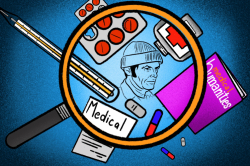What is HIV and how do they treat it?
HIV attacks cells of the immune system, primarily leukocytes. Those are produced by hematopoietic tissues, mostly by bone marrow. From there, cells migrate into blood and other parts of the immune system, and spread around the mucous membranes close to the skin — in close contact with the outside environment. When HIV affects a leukocyte, it records its genetic code into the cell's genome, causing it to reproduce. Such viruses are called retroviruses. The affected leukocyte becomes exhausted and dies. Gradually, the immune system loses too much leukocytes and stops working, so the infected person becomes unable to fight off infections. Different lethal diseases develop; the last stage of HIV is AIDS — acquired immune deficiency syndrome.
The current method of treating HIV is antiretroviral medication therapy. It implies the intake of different types of drugs; most of its patients live for as long as the uninfected, but suffer from numerous diseases. These medications restrain the virus from reproducing and affecting the DNA, but do not cure the disease itself, as HIV can stay inside the leukocytes' DNA without being activated. Even if the organism will become free of all of the viruses "copies", it can develop from any cell of the immune system. Another drawback of medication therapy is that the patients have to take the drugs at a particular time every day during the rest of their lives. Also, not all of the infected get access to such therapy.
 HIV. Credit: 365news.biz
HIV. Credit: 365news.biz
Many patients with HIV develop malignant tumors, lymphomas, and leucosis. Malignant tumors are consequences of DNA defects in bone marrow cells, which lead to the increase of immature cells in blood flow. The infected become susceptible to infections, feel pain in bones and joints, experience anemia, hemorrhages, their wounds take longer to heal or don't heal at all. For treating diseases of white cells and lymphomas, such a procedure as transplantation of hematogenic stem cells is used — many call it bone marrow transplantation. Stem cells are immature cells that can develop into blood cells. They can be transplanted from a donor — that would be allogeneic transplantation, or one can use healthy cells from the patient himself (autologous transplantation). This method has been around for about 50 years and is widely used for treating diseases of white cells and lymphomas. It is expensive and risky, but it pays off.
The "Berlin Patient"
Still, not all people are susceptible to HIV. In 95% of cases, the virus gets into cells through protein receptors. If there are none of them, the virus can’t affect the cell, and so it dies. There are no such receptors in the leukocytes of people with a mutation in a particular gene in both alleys. There are only about 1% of people who are immune to HIV on the planet, most are from Northern Europe. Actually, there are many people who have such a mutation in St. Petersburg. If one has the mutation in one alley, he would be susceptible to HIV, but the disease will be a lot less acute.
 Timothy Brown. Credit: vstrecha.by
Timothy Brown. Credit: vstrecha.by
In 2007, it was discovered that resistance to HIV can be "transplanted" to a person. Thanks to it, Timothy Brown has become the first person in the world to ever be cured from HIV. Mr. Brown was diagnosed with HIV in 1995. In 2006, he was diagnosed with an acute myeloblastic leucosis. Mr. Brown went to get treatment at the Charité Hospital in Berlin, where Dr. Gero Hütter arranged for him to receive a hematopoietic stem cell transplant from a donor with the abovementioned mutation. After getting the transplant, Mr. Brown was cured from leucosis, and in two years after the HIV virus has left his blood. The "Berlin Patient" is still alive and has no need for antiretroviral therapy.
So, what happened to Timothy Brown? From the evolutionary point of view, it was a question of natural selection. New leukocytes that were immune to the virus got into the patient's blood. These leukocytes started to reproduce and grow in number. The virus attacked only the old, weak cells, so with time, only the new leukocytes were left. As a result, the virus could no longer reproduce, and all of its copies eventually died out. Thus, Brown's organism became clean of the virus.
How to use this method to cure all of the infected?
Despite all the efforts taken by different research establishments, including St. Petersburg's R.M. Gorbacheva's Research Institute of Pediatric Oncology, Hematology and Transplantology, no one could repeat the success of the "Berlin Patient" case. Finding a compatible donor for treating leucosis is really hard, and finding such a donor with resilience to HIV is even harder. So, scientists started to look for a way to induce such resilience in the cells of the patient. Theoretically, it is possible to remove the protein receptor from the cell's surface. Then it won't be susceptible to HIV, and will die out. So, how can it be done? The answer to this question was found by a team of German and Russian scientists from the University Medical Center Hamburg-Eppendorf and R.M. Gorbacheva's Research Institute of Pediatric Oncology, Hematology and Transplantology led by Professor Boris Fehse and Professor Boris Afanasiev.
 ITMO University. Marina Popova
ITMO University. Marina Popova
"The method is based on studying the changes in the DNA sequences. We use site-specific genome editing to simulate the mutation that provides the cell's resilience to HIV. If that is done with bone marrow cells, then a patient can be cured from HIV", explains Marina Popova, senior research associate at the R.M. Gorbacheva's Research Institute of Pediatric Oncology, Hematology and Transplantology.
To remove the HIV protein receptor from the leukocyte, the scientists "cut" the piece of the DNA that is responsible for its reproduction. For these, artificially created proteins called "molecular scissors", are used — they break the DNA sequence where the particular gene is located. As such breaks occasionally occur as results of natural processes, the DNA has corresponding restoration mechanisms. After restoring itself, the part of the genome that encoded the presence of the HIV protein receptor mutates. Consequentially, the protein changes as well — it loses the property that allowed HIV to enter the cell. The elaboration of these new cells launches the evolutionary mechanism which, with time, leaves only the HIV-resilient leukocytes. There is still no precise data on how many HIV-resilient cells are needed to successfully cure HIV, yet, most scientists agree that it has to be within 1 to 10%.
One can think that the process of "cutting" the DNA takes place inside the patient's tissue; this is not true. The genome is edited outside the organism. Prior to editing, bone marrow cells are taken from the patient. Then, the DNA of these cells is modified at a special laboratory, and the new cells are injected into the organism.
"We make use of natural biological processes: the cell does everything itself. We know we can store bone marrow cells outside the patient, so we do all the necessary modifications in a test tube", shares the head of the AGCT.
High-technology medical startup
The AGCT Company develops genome editing, which is a flagship project in terms of HIV treatment. As result of the project, the team will provide services in editing the DNA and modifying the cell's biological properties in their laboratory. The patient's bone marrow cells will be sent there to be modified and sent back as HIV-resilient cells. The company will be working with both governmental contracts and private clinics.
 AGCT representatives at Startup Village. Credit: tass.ru
AGCT representatives at Startup Village. Credit: tass.ru
As of now, the AGCT has been around for only a year; at the current stage, it conducts pre-clinical trials and looks for investments. The clinical trials will take two more years. According to the startup's head, attracting investors has been easy. Four major investment funds have contacted AGCT after they've presented their project at the Startup-Village in Skolkovo last year. In December, the project has been presented to Prime Minister Dmitry Medvedev, who highly appreciated it. The company also got into the road map of the HealthNet National Technology Initiative Market which deals with initiatives in medicine and healthcare. ITMO's Technopark also provides the company with additional opportunities for elaborating business contacts and searching for financing.
"Using DNA-editing, we can now treat patients with HIV; yet, the capabilities of our technology are much greater. It is humanity's first instrument that allows correcting mistakes in DNA sequences, not just treating their consequences. As of now, we actively research approaches to treating many socially significant genetic diseases by transplanting modified hemopoietic stem cells, as well as using this method in the field of cancer immunotherapy. Another reason to our project's significance is that it has to do with promoting Russian science as a whole, not just our clinic or city. There are advanced inventions in the field of treating HIV in China and the USA, though those use different methods. Yet, Russia may well become the first country to invent and introduce an effective method to treating this disease", notes Marina Popova.





